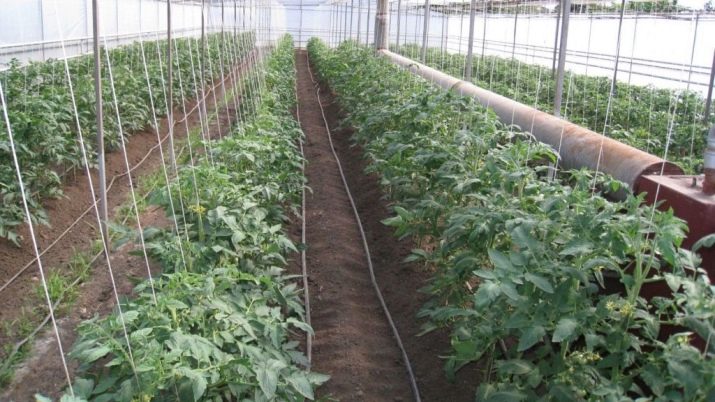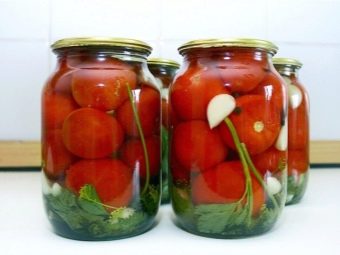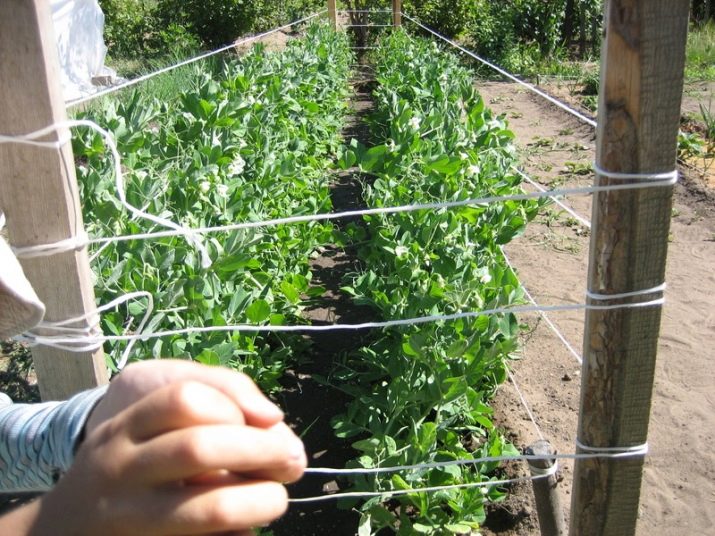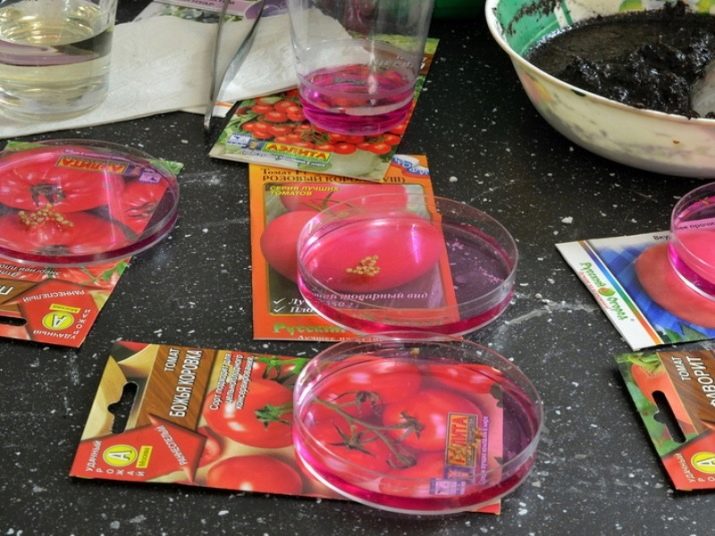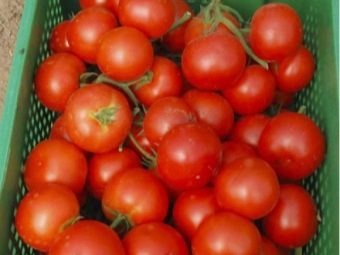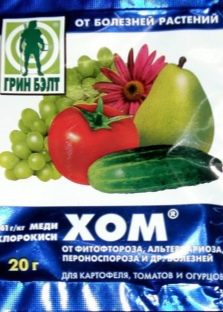Tomatoes "Evpator": features of the variety and fineness of breeding

Tomato "Evpator" - the brainchild of modern breeding. The grade is intended for cultivation in greenhouses.Vegetable growers rightly call it a real miracle. It perfectly resists characteristic diseases, is famous for its high yield and rich pleasant taste.
Characteristic
Evpator is an indeterminate standard F1 variety. This unique hybrid is very popular among vegetable growers. It was developed by domestic scientists in 2008. When describing a variety, it should be noted that it refers to tall. The height of the bush can reach 2 meters. The average plant height is 140-180 cm.
Given the indeterminacy, it can be concluded that the bushes need careful formation. They must be pasynkovat, leaving only 1-2 of the main fruit-bearing stalk.
They, as a rule, are long and thin, because of what they need to be often tied to a high support as they grow. The leaves have an average size, elongated shape. The roots of the fibrous system penetrate the ground to a depth of no more than 30 centimeters.
Tomatoes "Evpator" bred exclusively for growing in greenhouses. The fact is that they grow and produce crops for a long time. In greenhouses, you can best protect the plant from the adverse effects of the external environment and maintain a certain microclimate from early spring to late autumn. Accordingly, in such conditions it is possible to collect the greatest possible harvest.
When creating a favorable microclimate with one square meter can collect up to 45 kg of tomatoes. Of course, this variety can be grown in open ground, but the yield will be significantly lower.
"Evpator" refers to srednerannymi varieties. On average, it takes about 100 days from the moment of germination of seeds to ripening of the first fruits. The hybrid is resistant to the development of diseases and attacks of pests, very convenient for cultivation on an industrial scale.
From the moment of seed germination to tomato ripening takes about three months. Tomatoes are medium in size, weighing about 130-170 grams. Fruits have a rich red color, smooth, flat surface. Form - slightly oblong. The flesh of the tomatoes is dense, but juicy. Due to the density of the peel on the fruit does not appear cracks with rapid growth.
Ripe tomatoes have a rich taste and bright aroma. They harmoniously combines sweetness and light sourness. The fruits of this hybrid are suitable for the preparation of various dishes, tomato juice and preservation.
The dense texture allows the fruits to maintain integrity and freshness for a long time, so they can be safely transported over long distances.
Virtues
The advantages of this variety are confirmed by numerous reviews of farmers:
- high yield;
- resistance to many diseases characteristic of solanaceous crops;
- good organoleptic characteristics;
- the optimal size of the tomatoes, so that they can be preserved even whole;
- resistance to various parasites and pests;
- fast and uniform fruit ripening;
- rich taste, dense fleshy texture;
- unpretentious hybrid when grown.
disadvantages
However, this variety has some disadvantages:
- the need to form a bush, regular garters to the support;
- intolerance to strong winds due to the high growth of the stems;
- the impossibility of self-preparation of seeds (in seeds collected from the fruits of the hybrid, the main varietal characteristics do not appear, therefore, planting material must be purchased in specialized stores).
These shortcomings, with the exception of the latter, can be called very minor. The virtues of the variety are easily outweighed, which affects the popularity of "Eupator".
How to grow?
To obtain a rich harvest, you should know some of the subtleties of the growing process and follow all the recommendations of the breeders who brought this variety. Planting seeds produced in March - early April, depending on weather conditions.After 45 days, the seedlings are transplanted into the closed ground. It should be light, room temperature. To provide the soil lightness and loose structure, it is necessary to mix in equal parts simple earth, turf ground, peat and humus.
It is recommended to hold the prepared soil for 1-2 weeks in a warm place for even warming up. Before planting should be treated with a weak solution of potassium permanganate, pour boiling water or calcined in the oven. This will prevent pests from occurring. It is not necessary to additionally process the seeds before planting.
Planting seeds
Prepared soil is poured into a box about 12 cm high. Seeds are placed in the grooves made in advance, having a depth of 1 cm. There should be a gap between the seeds of 2-3 cm. Fill the grooves with earth. The gap between them should be about 3-4 cm. After planting, the box should be covered with foil or glass and placed in a warm room. It is recommended to maintain a temperature of about 23 degrees.
A pick (transplanting into individual cups or pots) is carried out after 2 true leaves appear on the stems. At the same time, weak, painful seedlings can be immediately thrown away, it will not yield much yield. The volume of the pots should be 200-400 g. This is quite enough for the root system of the culture.
Before transplanting plants in a greenhouse, young plants must be hardened. To do this for a short time, they should be transferred to a greenhouse.
The height of seedlings at the time of transplanting to a permanent place should be no less than 15 centimeters. Such plants will be less sick.
Landing in the greenhouse
It should be noted that tomatoes are not recommended to be planted on the same plot where other crops from the family of nightshade were growing before. This may contribute to the development of diseases. Transplant seedlings in a greenhouse should be when the frost will be. This is usually the end of May or the beginning of June. The optimum temperature for normal growth and ripening of fruits is 24-28 degrees.
The soil in the greenhouse should be dug up to a depth of about 20-30 cm. Plants should be planted at a distance of 25 cm from each other in a moist soil. 60 cm should be left between the rows. Plant the seedlings in the dug holes and sprinkle them with earth.
Care
Mandatory procedure is dressing. After 10 days after transplanting in the greenhouse, plants can be fed with complex fertilizers or ammonium nitrate. The solution is prepared simply: 1 tablespoon of the drug is diluted in a bucket of water at room temperature. Under the bush is poured 700-1000 ml of the resulting solution. The following feeding is carried out 10-12 days after the first. To feed the tomatoes need only on wet soil, so as not to injure the root system of the plant.
Watering should be as needed. Watering should be abundant, but it must be ensured that the soil is not too wet. Warm water is used for irrigation. In the process of irrigation moisture should not fall on the leaves. After watering, you need to carefully loosen the soil.
It is important to note that during the flowering room greenhouses must be aired. Tomatoes are self-pollinating, pollination can be carried out without the help of insects. There are both female and male reproductive organs on flowers. Air circulation helps them to pollinate. You can also resort to pollination manually. Bushes need regular garter to high support.
It is necessary to tie up every 15-20 cm. Otherwise, a thin stem of a plant can not withstand a large weight of fruits and break under their weight.
Passing seedlings must be mandatory. The greatest yield is obtained with a growth of 1 stem. Remove extra stepchildren recommended in the morning. So the plant will recover faster after a painful procedure. Remove stepchildren need to be correct (they should be twisted). It is advisable to do this in dry weather, so that the resulting wounds heal faster.
Toward the end of summer, a small upper part of the stem can be broken off. After that, the plant will direct all the vital forces to the ripening of fruits, will cease to branch and stretch upwards. Usually, these manipulations are carried out when 6 brushes are already fastened on the bush. After this, the lower leaflets also begin to tear off. It is necessary to remove them gradually, no more than two leaves per day, in order not to injure much the stem.
The first crop ripens 100 days after the germination of the plant. Observing all stages of the growing process, timely carrying out all the necessary activities, you can collect up to 6 kg of tasty fruits from each bush.
Diseases and pests
Despite the genetic protection of the variety from diseases characteristic of solanaceous crops, The following troubles may occur:
- fomoz;
- dry spotting;
- scoop caterpillar (you can get rid of it manually or using Strela);
- whitefly (“Confidor” preparation will help get rid of it).
To cure bushes, the following measures should be taken:
- pick fruits with signs of disease;
- reduce watering;
- reduce the amount of applied nitrogen fertilizers;
- in case of severe damage to the plant, it is possible to use specialized preparations - fungicides, insecticides (for example, “Tattu”, “Hom”, “Antrakol”).
As you know, chemicals - not the safest and most environmentally friendly way of dealing with insects and diseases. This may affect the fruits. Therefore, the use of chemicals is allowed only in cases where there is a likelihood of a threat of destruction of the culture.
The best treatment is prevention. To reduce the likelihood of developing diseases and the appearance of pests, it is recommended to take preventive measures, such as regular loosening, weeding, mulching, airing the greenhouse.
Also experienced gardeners recommend the following plant protection measures:
- prevent overmoistening of the soil;
- remove the bottom leaflets;
- sprinkle the culture with copper-containing substances (this procedure should be carried out in 3 stages, before the formation of the fruit).
In conclusion, we can conclude that the variety "Evpator" is unique. It affects high yield, tasty fruits with a bright aroma, as well as resistance to mechanical stress. The main goal of domestic breeders was to create a commercial type of tomato. They succeeded. Hybrid "Evpator" liking and those who grow vegetables for their own needs, and farmers who pursue commercial goals.
In the next video, see important information about tomato cultivation rules.



